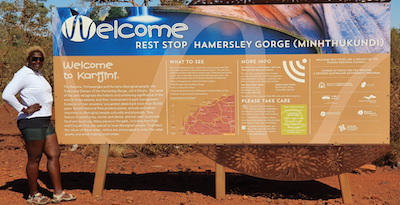
For your comments and feedback, please write this in the comment box immediately at the end of this write-up.
We wish you a pleasant reading as we share our life adventures with you, in the hope that some aspects of them will resonate with you or someone you know or, at the very least,encourage you to go out and explore.
So how did we get here? We had given thoughts to making accommodation reservations when we started but felt these were, in most cases, unnecessary and chose to plan as we go. Our choice was largely influenced by the fear that pre-booking our accommodation will commit us to a rigid schedule. What if we come to like a particular place and choose to spend more than the number of days planned there? This was the case when we got to Broome and, had we made reservations for Karijini, we would have lost money. Unfortunately we did!
While in Port Hedland, we sought for accommodation in Karijini and it was there that reality hit us hard. The Eco Retreat, the only non-camp like accommodation within the park was fully booked out for the next 6 months. The alternative, if we were insistent on staying within the park grounds, was either the Dales campground or its overflow. The Dales campground was also fully reserved and we could only get a 2 night reservation at the overflow. We paid the fees for the 2 nights but lost our reservation when we chose to stay extra nights in Broome. It was such that the only comfortable accommodation that we were left with was the Auski Village, 65kms away from the park or 90kms away in Tom Price. We chose the former.
The night at Auski Village was uneventful, except for the man next door who kept tapping at the wall panel that divided our rooms from his side. When I asked him what he wanted, he requested that we turn the volume on our television down. Though the volume was low already, we reduced it further and finally gave up on watching TV totally and switched it off. We slept off and had a good night sleep in the port-a-cabin. These port-a-cabins were decent enough and similar to the same ones that we had slept in, earlier in South Hedland. The only difference was that these were not rigorously tied down like those in South Hedland. Cyclones are not much of a consideration here.

It was cold when we woke up in the morning and I was very happy when Saf gave me a hot cup of coffee that she had made. This area of the Auski Village was desolate, the construction vehicles and the people we had seen the previous night were gone to work. With the cup of coffee in hand, I took a walk around our immediate surrounding. I became conscious of how close to the village the Hamersley range was. If I had wanted to, I could have walked out of the village and get to the mountain within 20 minutes. I paused and took time to admire this ageless mountain in the near distance. Apart from the sound of human activities coming from the other side of the village, it was all calm here. I wanted to get a chair and just sit here, enjoying the calmness from the view but the early morning cold would not let me. I continued on my walk and was soon at the other side of the village, the camp side. Everywhere here, was red dirt, except for the patch of grass on which people are camping. There were different forms of tents and recreational vehicles dotting the park. It was evident that some had been here for a long while. A few families were up, making breakfast and preparing their vehicles for their planned commute for the day while the snoring from a few tent showed there were still some not yet awake.
I walked back to our section of the village just at the nick of time. Saf’s voice rang out, “sweetheart, where are you, are you already loading up the vehicle?” With meals done, we jumped into the Explorer, full of energy and were eager to see what Karijini had for us. As we dropped our room keys at the reception to check out, we asked the lady if there was any shortcut through which we could get to the Hamersley Gorge. Oh no, you just have to follow the Munjina Road for a little over an hour and you will be there, she responded. It was taken for granted in this area that everyone drove a four wheel vehicle.

Exiting the road house, we joined the Munjina road. It quickly dawned on us that a road does not necessarily mean a sealed, properly paved route. Approaching us, from the other side, was a dusty construction ute with its “buggy whip” providing visibility from the red dust that swirls around it as it sped towards us. We didn’t realise it then but we would soon be eclipsed by this same dust as we drove on this road. The Munjina road is an unsealed red gravel road that runs round the northern boundary of Karijini through low bushland. The terrain here is desolate with no facilities for the commuters. This desolation makes for unobstructed views of the mountain range that was on our left. The entire right was low lying bushland.
For extreme tourism enthusiasts, the entry point to the abandoned town of Wittenoom is off this road. The warnings were unambiguous, “steer clear!” The town was abolished by gazette in 2007 as a result of asbestos contamination and is regarded as the largest contaminated site in the southern hemisphere. We were not suicidal and going to explore the ruins, if any, was not of interest to us. As we passed the exit to Wittenoom, the road becomes the Nanutarra road.
A little further ahead, a train line runs parallel to the road, the steel barricading the line from the road glisters in the morning sun. We concluded that it probably was a new extension of an existing line as it has the ballast and wooden cross ties all have some newness in their look. There were a few workers fixing something on the line. Whatever was being done, extended to the road and we were soon brought to a halt by the construction crew.
Going through the section of the road that cuts through Mount Sheila, we could almost touch the rocks. We saw the different layers of sediments that made up the rock. Each layer tells a story of the formation of the rock and the conditions on earth as at then but we can’t hear what was being said. A geologist would have a field day here, telling an interesting story of how these rocks came to be. Suddenly we found ourselves on a sealed road, this was a welcomed relieve. The road is narrow and snakes through the mountain and as suddenly as it appeared, it disappeared. We were back on unsealed road again and soon came to the well signposted turn to Hamersley gorge. We were now off Nanutarra road.
The entire park that is home to these beautiful gorges, of which the Hamersley is one, used to be called the Hamersley National Park. F.T. Gregory, an European explorer is credited with having named the Hamersley Range, a major feature of the park, after his close friend Edward Hamersley following his exploration of the area in 1861. The park’s modern name, Karijini, originates from the traditional Aboriginal land owners who have lived in the vicinity of this area for thousands of years. It seems someone had finally listened to the words of Lola Young. But then, it challenges our thinking to understand why the name of the mountain range has not been changed as well.
When we arrived at the parking lot, it was as if every adventure seeking Australian was there for a meeting. The Hamersley gorge is the most remote gorge to visit and the almost desolate travel on the Munjina-Nanutarra road had given us the false impression that we were the only adventurers in this remote north-western fringe of Karijini. We were wrong, very wrong. To get a parking spot for the Explorer, we had to go in circles twice. Even with that, we had to tuck the vehicle up in a bushy land off the road and took a long walk down to the entrance to the gorge. All the vehicles here, without exception, were covered in red dust, a sign of the long tortious route many had taken to arrive here. As we started meeting with the people, all the age groups were represented, the kids and older adults were here as well.
Curiosity took over us and we were suddenly in a haste to get down into the gorge to experience whatever adventure that was captivating enough to have attracted all these folks over here. As we approached the entrance to the Hamersley Gorge, we stopped to read some of the notices and guidelines on the black steel boards.
Out of no where, a middle-aged gentleman tugged at my shirt and asked to know where I was from. I told him and he said he suspected that much from my to nation. He mentioned that I looked and spoke exactly like his best friend and it was this that attracted him to me. I asked him about this friend of his and his face suddenly turned sorrowful – He is dead. He died of pancreatic cancer. I felt like embracing him but resisted it. He went on to tell me about this man. They had met in Sydney and had developed a close bond as they grew up and he could vividly recollect this man’s popular phrase as “unbelievable!” We parted ways. While he made for the park exit, we took the short walk down some steep rock steps into the gorge. The steep and uneven steps meant that many older adults could not make it down into the gorge and remained content with looking at it from above.
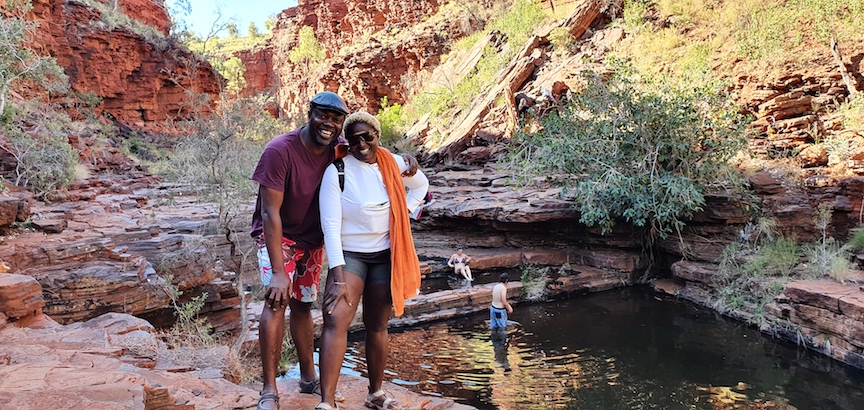
There was a sizable number of people in the pool when we finally got there and the water in the swimming hole was frigid. It was a bit crowded, mostly with kids sliding down the side of the rocks, jumping, splashing the water and making loud noises as they express their excitement. Saf already had her swimming trunks under her clothe and all she had to do was to pull off her top. I looked for a less crowded end of the pool and changed into my swimming pants. We just had to experience the waters in the tree-fringed pools here. The surrounding rock revealed its beautiful layers. The sediments making the rock were in different colours and these were marvelous to look at, along with the preserved vegetation. A sense of calm descended on us and we were soon lost reveling in this beautiful work of nature.
At one end of the pool, the water tapers as it flows through a narrow opening it has cut through the enormous rocks over the years. At this point, words are inadequate to describe the scenery. I wasn’t bold enough to swim to the end knowing the limits of my abilities. Saf, being a better swimmer than I was, was moving in the pool like a dolphin. I was getting very cold and was soon out of the water choosing to wrap myself with the huge towel we had brought and enjoy the views. Our plan for the day included visiting the Weano and Hancock gorges and I had to call Saf to stop swimming so that we could be on our way. She wasn’t the happiest of women on earth as she came out of the pool but she understood why her fun had to be cut short.
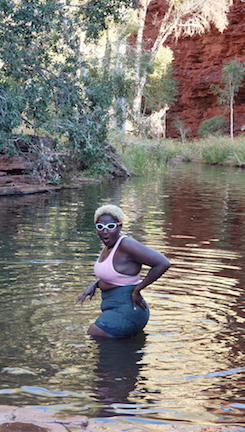
Getting out of the gorge took some effort, the steps were uneven and the slope steep. We did not bother to change and was content with laying our towels on the Explorer’s seat to prevent our wet bodies from spoiling them. We were back on the Munjina-Nanutarra road from where we turned left unto the Hamersley-Mount Bruce road, cutting off a visit to Mount Sheila. The road took us to Karijini drive and then following the Banjima drive we arrived at Weano gorge. It had taken us exactly 2 hours to cover the 95kms from Hamersley through mostly unpaved roads. At a point during our travel here, we were following a truck which was spurning so much red dirt in the air that visibility was almost zero.
It had been an interesting drive and by the time we arrived at Weano, we had circumnavigated the entire Karijini park. Almost. Now we were right at the heart of the park. We pulled the Explorer into the day use area ( also called picnic area). We were famished but more excited to see what lies beneath the gorge here. At the entrance to the gorge, the gateway was made of two giant oxidising brownish metal boards. We were busy reading the write-ups on these when a voice cuts through. “Unbelievable“, it was the man we had earlier met at Hamersley calling us. We looked ahead and we all burst out laughing, as our eyes met. He was approaching us from the gorge and I repeated the word “unbelievable!” He said that was exactly how his friend spoke it and requested that I say the word again. This time we embraced.
He departed the area while we took the short walk into the gorge. From here, we followed the 1 km gorge trail. Even the most difficult to please of all creation will marvel at the grandeur and enormity of these rocks. Looking into the sky from its deep recess, walking through magical narrows and watching the water snaking through these and becoming a trickle in some places provided a window into how living was meant to be. At this point I remembered the Yoruba song and started humming it:
Olorun t’o dà àwọn òkè Igbani
Eyin ni mo fi ope mi fun
T’ani N’wo tun gbe ga o
Bi Ko se Baba l’oke
Tani N’wo tun fi gbogbo Ope mi fun
Olorun t’o da awon Oke Igbani
Eyin ni mo fo Ope me fun
In English
The Lord who created the ancient Hills
To you I will give all my praises
Who else will I exalt
If not you, father in heaven
Who else will I give all my praises to?
The Lord who created the ancient Hills
To you I will give all my praises
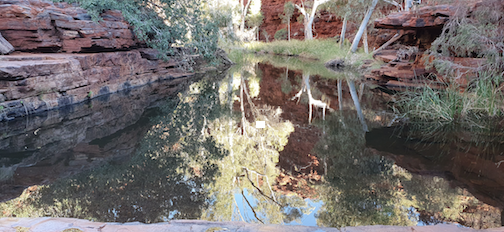
We touched the rocks that were in many places like slabs, sheets upon sheets of solid. This walk offered some beautiful picture taking opportunities and we took some. My photogenic wife would not stop interrupting me from proceeding further, she was perpetually asking me to take her pictures at different spot. It was like with every step we took, I had to stop and take her a picture.
At the Handrail Pool, it was a different scenery altogether. The rocks were like sheets of tiles of different thickness, lengths and coloration. All shades of brown were present. The water rolling gently, cascading over them into the pool provides a soothing natural sound. The scene was indescribable and soon we got into the pool and were little children all over again. We spent quite a bit of time here, playing with the water, climbing up the rock and generally were attuned with nature. It was probably the highlight of our visit to this wonderful park.
Finally it was time to leave and the walk or climb out was a little challenging as we had to go over steep rocky steps. Once out, we headed to the Oxer lookout. Our walk was rewarded with breathtaking panoramic views of the four gorges in the vicinity – Weano, Red, Joffre and Hancock. From here, we saw the tiers of banded iron formation towering over a pool at the bottom of one of the gorges.
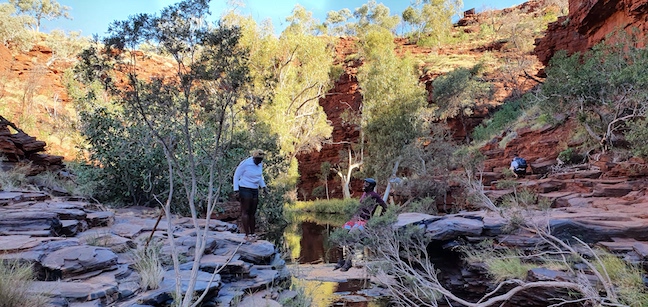
People have died in this park. The causes of death range from flash flooding in the gorges, to falling over cliff edges, exhaustion and drowning. Danger was lucking all around us. As with everything Australia, there are more than one way to die here. Knowing the prevalence of these risks, we were very careful to consider each and every activity we did to avoid them. We were not going to be part of the statistics here.
Our next stop was the Hancock Gorge but by the time we got here, we knew we had seen much of the gorges. After all, we had said, a gorge is a gorge. Tired, we did not enter the gorge and was satisfied to look at it from its entrance. It was time to look for food and a place to rest our tired bodies.
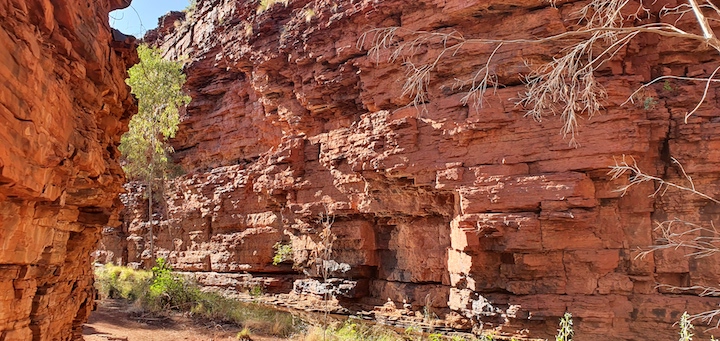
Arriving at where the Explorer was, there was a park attendant going around the place. Since I had not displayed a park admission ticket, I was afraid that he had booked my car and we would be receiving in the mail a citation for this. I approached him and engaged him in a conversation. He mentioned he had seen our vehicle at Dales gorge the previous day. I was amazed at his memory, noting how many vehicles move around the park daily. We told him about our journey so far and he recommended that we do a couple of more visits to other gorges before we leave.
We drove the next 84kms and arrived at a rest area at the intersection of Karijini drive with the Great Northern Highway. For safety reasons, we wound not proceed to Tom Price and chose to camp here for the night. By the time we got there, there were already two caravans set up for the night. It was going to be another Jesus slept in a manger night. We prepared our meal and ate. As we retired for the night, other adventurers started showing up at the rest area and before we knew it, the place had turned into a little village.

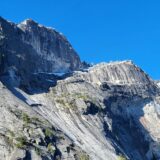


A ray see
Very interesting read! Very well detailed. I felt like I was there in person. Now I want to go to Australia.
bimbo
Eresi,
Thanks for the comment. Be rest assured you will warmly be received if you decide to visit.